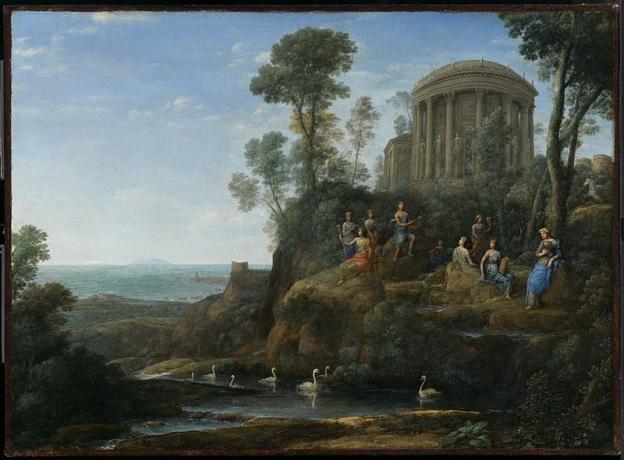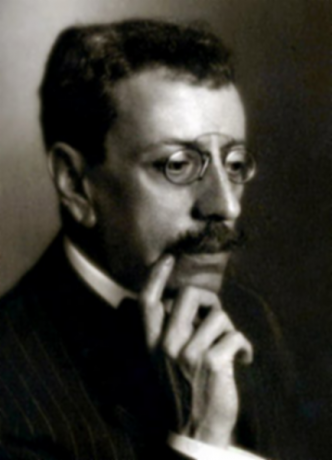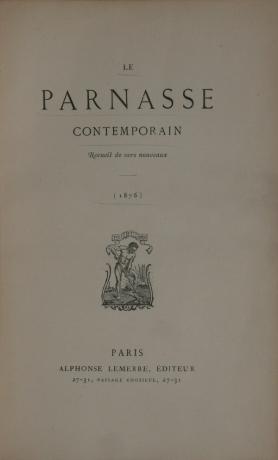O Parnassianism in Brazil it became a trend in poetry around the 1880s and established itself as a canonical style until the early 1920s. Exclusively poetic literary movement, which emerged in Paris in the mid-1860s, came to stay in Brazil.
School of the well-known poet Olavo Bilac, who dedicated himself to talking about Greco-Roman references, the name parnassianism it originates from Mount Parnassus, a mythological and lyrical Greek landscape that guarded the Castália fountain, whose waters inspired poets. For the Parnassians, however, inspiration was not enough: the word should be cut, like the work of a goldsmith. THE obsession with form, for their rhythmic perfection, their fixed meter and the horror of sentimental raptures and free verses from the romantic period are marks of the production of this aesthetic movement.

Historical context of Parnassianism in Brazil
The last decades of the 19th century were marked by great political turmoil in Brazil. abolitionist movements and republicans rose up against the monarchical order of Dom Pedro II, already worn out by the long years of Paraguay War. At crisesinternal led to the abolition of slavery in 1888 and the Proclamation of the Republic, the following year, putting an end to the Brazilian monarchy.
Previously consolidated in the sugar economy of the Northeast region, Brazil experienced, at the time, a displacement from its economic center: it was mainly during the 19th century that the Brazilian economic hub became the Southeast region, based on coffee economy. And it was mainly in the last decades of the 1800s that the industrialization began to take place in Brazil, bringing with it the modernization and the increase in urbanization.
The Parnassian poets were, for the most part, also republicans. This political ideal, as well as the Parnassian movement as a whole, was imported from France, a country that greatly influenced nineteenth-century Brazil artistically and intellectually. Also French was the thinker Auguste Comte, precursor of the current of thought called positivism, whose theoretical proposal was based mainly on the objectivity of the scientific method.
Only through the rigorous method of the natural sciences would we reach the progress, and the entire trajectory of human history until then would have been a mere rehearsal to reach this stage of scientific knowledge that had been structured from the 19th century onwards. And this horizon of scientific and rational objectivity also crossed Brazilian Parnassian poetics.
Read too: Segundo Reinado – period in the history of Brazil when D. Pedro II was in power
Characteristics of Parnassianism in Brazil
Exclusively poetic movement: Parnassianism devoted itself only to the form of poetry. There are no Parnassian productions in prose or dramaturgy.
“Art for art's sake": one of the main creative horizons of Parnassian production was the idea of a poetic art focused on itself herself, free from any commitment to social reality or to the moral and political intentions of any type.
Objectivity and impersonality: anti-romantic, the Parnassians sought to build their lyric with the smallest traces of subjectivity. Objects, landscapes, historical or mythological characters are frequent themes in his poems, which go far from sentimental outbursts and preserve sobriety and rationality.
Cult of form and erudition: formal rigor is a hallmark of the movement. The Parnassians sought perfection in the form of the poem following traditional rhyme patterns, rhythm and metric. Parnassian poetry prefers rhymes rare and to elaborate words, the result of a yearning for the refinement of poetic expression and contempt for images and expressions already worn out by romantic poems. It also involves a desire for elegance and the spiritual aristocratization of the word.
Important aspects of Parnassianism in Brazil
Parnassianism was established in Brazil at the same time that the aesthetic currents of the realism It's from naturalism. Generally speaking, there is a widespread wear of the artistic trend of the romanticism, which dominated more than half of the 19th century and established itself as a canon in Europe and also in Brazil. After three generations of romantic poets, the movement has petered out.
O starting point of Parnassianism in Brazil is understood as the Publication fanfares, 1882, signed by the poet Teófilo Dias. But the Parnassian popularity is mainly due to the dissemination of Parnassian precepts in Brazil made by the chronicler, professor and literary critic Artur de Oliveira, who had direct contact with the main Parnassian poets French and, when he returned, he brought with him the aesthetic premises of the movement, widely publicizing the work of this new poetry European.
Upon arriving in tropical lands, the impersonality of European Parnassianism lost some of its rigidity and acquired less impassive tones. The cult of form and the well-finished and refined vocabulary search, however, remained, as well as the consequent language elitization and aristocratization of the poetic word.

Parnassianism knew how to make itself canonical in Brazilian lands and had long duration in Brazil, extending as main aesthetic trend mid-19's 1880 until the middle of the decade of 1920. It was with the advent of brazilian modernism, which vehemently rejected the Parnassian poetics, that this artistic school fell, little by little, into disuse. However, it left its mark present over the years: the current lyrics of Brazilian National Anthemit is a permanent example of Parnassian composition. Written by Joaquim Osório Duque-Estrada in 1909 and improved by the author until reaching the version we know, acquired by the Union in 1922, the anthem owes the refinement of its words to the Parnassian style in vogue in the era.
See too: Romanticism in Brazil - movement that tried to bring national identity to light
Main authors of Parnassianism in Brazil
Alberto de Oliveira
Alberto de Oliveira, whose full name is Antonio Mariano Alberto de Oliveira, is known as the first Brazilian Parnassian. Born in Palmital de Saquarema (RJ), on April 28, 1857. A pharmacist by training, he also served as a teacher, civil servant and General Director of Public Instruction in Rio de Janeiro.
His debut in poetry was still following the school of romanticism, with the publication of romantic songs, in 1877. It was at the beginning of the 1880s that Alberto de Oliveira started to receive in his house a group of composed intellectuals, among others names, by Raimundo Correia and Olavo Bilac, alongside which he would be recognized with the epithet of the “trinity of Brazilian Parnassianism”.
He was a founding member of the Brazilian Academy of Letterss and obtained great literary recognition and glory while still alive, having also been elected prince of Brazilian poets in 1924. His work is very vast and is from the publication of southern (1884) that the author consolidates the Parnassian style in his poetic work. From its style and recurring themes, the detailed description of the images stands out, as if composing a painting, the portrait of a scene.
Throughout his life, Alberto de Oliveira also contributed to several Rio newspapers. He died an octogenarian, after witnessing the end of his poetic school and also of his glory, in the city of Niterói, in January 1957.
Raimundo Correia
Raimundo Correia he was born aboard a ship off the coast of Maranhão, on May 13, 1859. Son of judge José Mota de Azevedo Correia, Raimundo exercised the profession of diplomat, magistrate and teacher, as well as poet. His literary debut took place in São Paulo, in 1879, with the publication of Little dreams. Shortly thereafter, in 1883, he published the volume Symphonies, which contains a famous sonnet entitled "The doves", which gave him the nickname “poet of doves”, which the author openly detested.
With a more sensitive tendency than its peers, Raimundo Correia's poetry gives way to nuances of shadows rarely seen in other Parnassian poems. Sometimes, comes close to aesthetics symbolist, by brilliantly expressing kinesthetic sensations through his verses. An expert sonnetist, he was appointed by Manuel Bandeira as the author of "some of the most mysteriously beautiful verses in our language."
Tuberculous, he left for France in search of treatment in 1911, where he died in September of that same year. In addition to poetry, Raimundo he also wrote chronicles, essays and works of literary criticism.
olavo bilac
olavo bilac é the most famous of the Parnassian poets and also one of the best known names in Brazilian literature. Born in Rio de Janeiro, Olavo Brás Martins dos Guimarães Bilac was born on December 16, 1865. Son of a doctor, Olavo tried to follow his father's career, but gave up the profession in the 4th year. He also tried to study law at Largo São Francisco, but abandoned the course in his first year. Dedicated his career to literature and journalism, especially to political journalism, having founded several newspapers and was also persecuted by Floriano Peixoto at the beginning of the republican period.
He debuted in literature in 1888 with the volume Poetry, in which he has already stood out for the lyricism and excellence in the form of the sonnet, with emphasis on the structure that is built in views of the last verse, the golden key, which ends the poem with great effect. Unlike his predecessors, Bilac began his literary career directly by making poetry in the Parnassian style. Eloquent, he spoke countless times about characters from Greco-Roman mythology, about epic characters from Brazilian history and also about sensual love and its sensations.
bilac he also produced works of literary criticism, children's poetry and even a textbook, as well as short stories and chronicles. He was one of the founders of the Brazilian Academy of Letters. He died in Rio de Janeiro in 1918.
Also access: Five poems by Olavo Bilac
Other important names in Parnassianism in Brazil
Other authors had significant importance, such as Frances Julia (1874-1920), whose Parnassian poetic work, according to some critics, actually reached the impassibility that the aesthetic horizon of the movement aspired, before starting to produce poems more associated with school symbolist. Equally important was the contribution of Arthur Azevedo (1855-1908), brother of writer Aluísio Azevedo, whose verses, in a humorous and satirical tone, full of puns, are unique among the movement's productions.
Main works of Parnassianism in Brazil
→ Olavo Bilac:
Poetry (1888),
Milky Way (1888),
fire bushes (1888),
Evening (1919) [posthumous].
→ Antonio de Oliveira
southern (1884),
Sonnets and poems (1885),
Verses and rhymes (1895).
→ Raimundo Correia
Symphonies (1883),
Verses and Versions (1887),
hallelujahs (1891).
Example of poem from Parnassianism in Brazil
to a poet
Away from the sterile maelstrom of the street,
Benedictine, write! in the coziness
From the cloister, in patience and quiet,
Work, and persist, and file, and suffer, and sweat!
But that in the form the job is disguised
Of effort; and the live plot is built
In such a way that the image is bare,
Rich but sober, like a Greek temple.
Do not show the ordeal at the factory
From the master. And, of course, the effect pleases,
Without remembering the scaffolding in the building:
Because Beauty, twin of Truth,
Pure art, enemy of artifice,
It is strength and grace in simplicity.
(Olav Bilac)
This poem, entitled “To a Poet,” is a good example of Parnassian composition. In regular metric, O sonnet it is decasyllable and structured in ABBA – BAAB – CDC – DCD rhymes. The title points out: the verses are dedicated to a verse maker.
The first stanza reveals that the poet of the title works in solitude, away from the “tourbillon of the street”, in seclusion associated with that practiced by Benedictine monks. It is with patience and sweat that the poet writes verses – not with inspiration or freedom. It's the art of cutting the word.
These verses are like the practice of a marble sculpture: must be cut to perfection, so that the shape is so well finished that it is worth the effort. So says the second stanza: the plot and the poetic image must reach a result similar to the Greek temples – wealth and sobriety. The taste for themes from Antique Classical is also a Parnassian feature, which is presented here, as well as the obsession with formal perfection.
In the third stanza, the poet points out that the hard work of making verses should not appear in the final result of the poem.. There is an association with the process of constructing a building: the final result must be of great effect, without the scaffolding – what supports the construction – being visible. This is what Bilac suggests for Parnassian compositions: they must be seen as a building, without revealing the enormous work that the poet had to build them.
Lastly, the poet ends the sonnet with the conception of a “pure art”, where beauty comes from – true beauty, made in simplicity, that is, without many flourishes or ornaments, but aspiring to impassivity and objectivity.
Read too:Pre-modernism - directions of Brazilian literary production in the beginning of the 20th century
Parnassianism in Europe

the parnassian movement appeared in France, with the publication Le Parnase Contemporain: recueil de vers nouveaux (O Parnasso Contemporâneo: collection of new verses), an anthology of poems published for the first time in 1866, but still circulating in 1871 and 1876. Several poets contributed to this collection of verses that redesigned the literary conceptions of the time, with emphasis on Théophile Gauthier, author of the poem L’Art (The Art), which dealt with the objectives of the Parnassian aesthetic proposal.
To combat the sentimental raptures of the romantic school, Parnassianism reacted with the obsession with form, in line with the new thinking that was being structured in Europe. Already dealing with the Second Industrial Revolution, with the industrial bourgeoisie consolidating itself in power, ideas such as scientism, the rigor of the scientific method and progress encouraged ideas already far removed from the proposal of romanticism. Objectivity has gained a central role not only in science and technology, but also in literature.
solved exercises
Question 1 - (Mackenzie) Does not characterize the Parnassian aesthetic:
A) the exaltation of the “I” and escape from the present reality.
B) objectivity, arising from the scientific spirit, and the cult of form.
C) formal perfection in rhyme, rhythm, meter and return to classical motifs.
D) opposition to the romantics and distancing from the social concerns of the realists.
E) the obsession with lyrical adornment and restraint.
Resolution
Alternative A. All other alternatives are characteristic of Parnassian aesthetics. Alternative A refers to the romantic school.
Question2 -(UFPE) It is incorrect to state that, in pParnassianism:
A) nature is presented objectively.
B) the arrangement of natural elements (trees, stars, sky, rivers) is important as it follows a logical order.
C) the valorization of natural elements becomes more important than the valorization of the poem's form.
D) nature gets rid of the exaggerated emotional charge with which it was explored in other literary periods.
E) the countless descriptions of nature are made within the myth of absolute objectivity, but the best texts are permeated with subjective connotations.
Resolution
Alternative C. Although natural elements appear frequently, the value of form is still greater than any other elements.
Question 3 - (And either)
secret evil
If the rage that foams, the pain that dwells
N’aIma, and destroy every illusion that is born,
Everything that stings, everything that devours
The heart, on the face, was stamped;
If it could, the spirit that cries,
See through the face mask,
How many people, perhaps, who envy now
Cause us, then pity cause us!
How many people who laugh, maybe, can
Guard an atrocious, hidden enemy,
How invisible cancerous sore!
How many people who laugh, maybe there are,
whose unique adventure consists
In seeming to others fortunate!
(BELT, R. In: PATRIOT, M. To understand Raimundo Correia. Brasilia: Alhambra, 1995.)
Consistent with the Parnassian proposal of formal care and rationality in thematic conduction, Raimundo Correia's sonnet reflects on the way in which an individual's emotions are judged in society. In the conception of the lyrical self, this judgment reveals that:
A) the need to be socially accepted leads the individual to act in a disguised way.
B) the intimate suffering becomes more mild when shared by a social group.
C) the ability to forgive and accept differences neutralizes the feeling of envy.
D) the instinct of solidarity leads the individual to pity his neighbor.
E) the transfiguration of anguish into joy is an artifice harmful to social life.
Resolution
Alternative A. The poet does not suggest that intimate suffering is alleviated through social sharing, nor does he presume forgiveness, solidarity or the acceptance of differences, and does not propose that social interaction is harmful due to the concealment of anxieties, masked of joy.
by Luiza Brandino
Literature teacher
Source: Brazil School - https://brasilescola.uol.com.br/literatura/parnasianismo-no-brasil.htm
